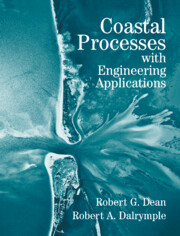2 - Sediment Characteristics
Published online by Cambridge University Press: 29 May 2010
Summary
On the southeastern shore of the Chesapeake Bay, parts of the shoreline are receding at very high rates of up to 10 m per year! Many of the shorelines in this region consist of narrow sand beaches backed by small bluffs several meters in height. The bluff, however, comprises considerably finer material than the beach and does not contain much sand-sized or coarser material. At Taylor Island, Maryland, for example, the mean diameter of the beach sand is greater than 0.5 mm, the bluff material is 99 percent silt, and the sand fraction has a mean diameter of 0.12 mm. Dalrymple et al. (1986) hypothesized that the high erosion rate there occurs because the erosion of the bluff yields only fine materials, which are easily transported away by the waves and tides, and contributes very little sand to the beach. Had the upland been composed of coarser material, bluff erosion would have produced more sand, resulting in a wider beach that would have slowed the bluff erosion.
INTRODUCTION
A beach can be composed of a wide variety of materials of many sizes and shapes. Remarkably, however, there is a very narrow range over which most beach materials vary, both in composition and size. Along the U.S. East Coast, for example, despite the variation in exposure to waves and the composition of the upland, the mean grain size of most of the beaches varies by a factor of only five (U.S. Army Shore Protection Manual 1973).
- Type
- Chapter
- Information
- Coastal Processes with Engineering Applications , pp. 21 - 34Publisher: Cambridge University PressPrint publication year: 2001



